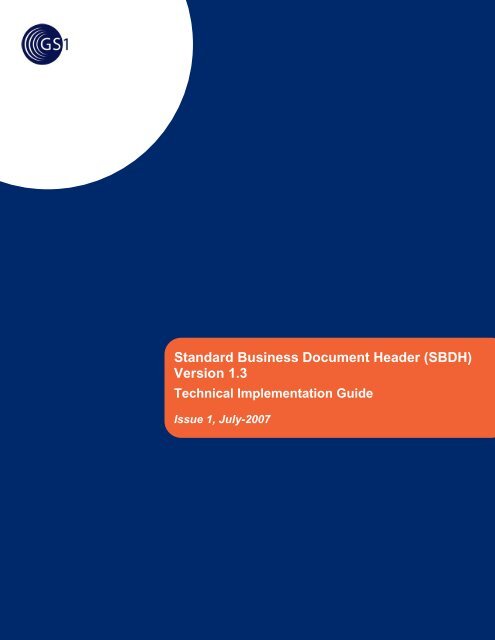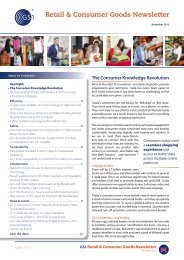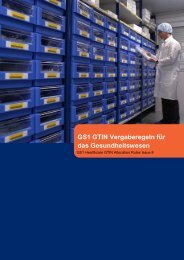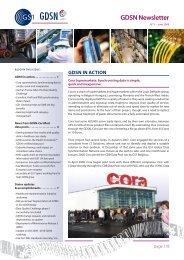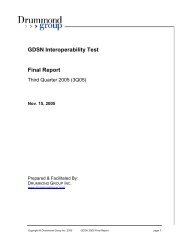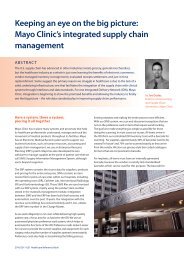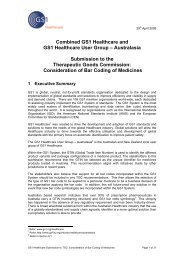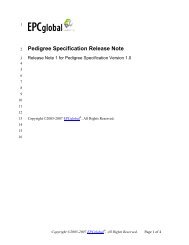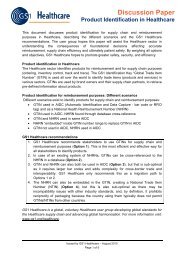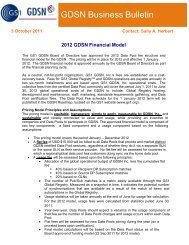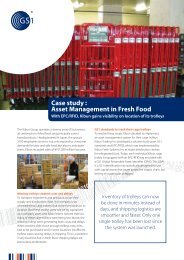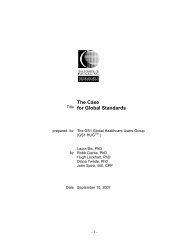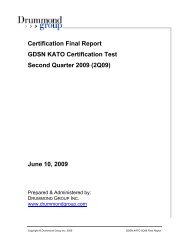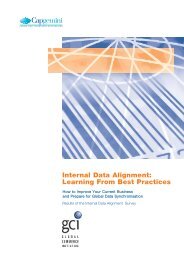SBDH Technical Implementation Guide - GS1
SBDH Technical Implementation Guide - GS1
SBDH Technical Implementation Guide - GS1
You also want an ePaper? Increase the reach of your titles
YUMPU automatically turns print PDFs into web optimized ePapers that Google loves.
Standard Business Document Header (<strong>SBDH</strong>) Version 1.3 - <strong>Technical</strong> <strong>Implementation</strong> <strong>Guide</strong><br />
Standard Business Document Header (<strong>SBDH</strong>)<br />
Version 1.3<br />
<strong>Technical</strong> <strong>Implementation</strong> <strong>Guide</strong><br />
Issue 1, July-2007<br />
July-2007, Issue 1 All contents copyright © <strong>GS1</strong> 2007 Page 1 of 21
Standard Business Document Header (<strong>SBDH</strong>) Version 1.3 - <strong>Technical</strong> <strong>Implementation</strong> <strong>Guide</strong><br />
Document Summary<br />
Document Item<br />
Current Value<br />
Document Title Standard Business Document Header (<strong>SBDH</strong>) Version 1.3<br />
<strong>Technical</strong> <strong>Implementation</strong> <strong>Guide</strong><br />
Date Last Modified<br />
July-2007<br />
Current Document Issue Issue 1<br />
Status<br />
Document Description<br />
Approved<br />
This document contains guidelines for implementation of <strong>SBDH</strong> with<br />
<strong>GS1</strong> XML.<br />
Contributors<br />
Name<br />
Dipan Anarkat<br />
Justin Childs<br />
John Duker<br />
Steff Span<br />
GSMP eTG Working Group members<br />
Organization<br />
<strong>GS1</strong><br />
<strong>GS1</strong><br />
P&G<br />
<strong>GS1</strong> Netherlands<br />
<strong>GS1</strong><br />
Log of Changes in Issue 1<br />
Issue No. Date of Change Changed By Summary of Change<br />
1 July-2007 Dipan Anarkat 1st Issue<br />
Disclaimer<br />
Whilst every effort has been made to ensure that the guidelines to use the <strong>GS1</strong> standards contained in the<br />
document are correct, <strong>GS1</strong> and any other party involved in the creation of the document HEREBY STATE that<br />
the document is provided without warranty, either expressed or implied, of accuracy or fitness for purpose, AND<br />
HEREBY DISCLAIM any liability, direct or indirect, for damages or loss relating to the use of the document. The<br />
document may be modified, subject to developments in technology, changes to the standards, or new legal<br />
requirements. Several products and company names mentioned herein may be trademarks and/or registered<br />
trademarks of their respective companies.<br />
July-2007, Issue 1 All contents copyright © <strong>GS1</strong> 2007 Page 2 of 21
Standard Business Document Header (<strong>SBDH</strong>) Version 1.3 - <strong>Technical</strong> <strong>Implementation</strong> <strong>Guide</strong><br />
Table of Contents<br />
1. Introduction ..................................................................................................................................4<br />
1.1. Purpose.............................................................................................................................................. 4<br />
1.2. Audience ............................................................................................................................................ 4<br />
1.3. Pre-requisite....................................................................................................................................... 4<br />
1.4. Process .............................................................................................................................................. 5<br />
1.5. Document Conventions...................................................................................................................... 5<br />
2. Overview .......................................................................................................................................6<br />
3. General <strong>Guide</strong>lines.......................................................................................................................6<br />
3.1. <strong>GS1</strong> XML Message Construction using <strong>SBDH</strong>.................................................................................. 6<br />
3.2. <strong>SBDH</strong> Tags ........................................................................................................................................ 8<br />
4. Context Specific <strong>Guide</strong>lines......................................................................................................14<br />
4.1. GDSN <strong>Guide</strong>lines............................................................................................................................. 14<br />
4.1.1. How to Use <strong>SBDH</strong> Tags in GDSN ......................................................................................... 14<br />
4.1.2. <strong>SBDH</strong> specialization in GDSN................................................................................................ 14<br />
4.2. EPCGlobal <strong>Guide</strong>lines ..................................................................................................................... 15<br />
5. Additional Information ...............................................................................................................16<br />
5.1. International telephone number format ............................................................................................ 16<br />
5.2. The use of the token ‘EAN.UCC’ instead of ‘<strong>GS1</strong>’........................................................................... 17<br />
5.3. Next version of UN/CEFACT <strong>SBDH</strong> specification............................................................................ 17<br />
5.4. Serialization...................................................................................................................................... 17<br />
5.5. Multiple Trading Partner Identification ............................................................................................. 18<br />
5.6. Message Grouping........................................................................................................................... 18<br />
5.7. Transport Protocol Options .............................................................................................................. 18<br />
6. References ..................................................................................................................................19<br />
A. Example 1: <strong>GS1</strong> XML Document with <strong>SBDH</strong>............................................................................20<br />
July-2007, Issue 1 All contents copyright © <strong>GS1</strong> 2007 Page 3 of 21
Standard Business Document Header (<strong>SBDH</strong>) Version 1.3 - <strong>Technical</strong> <strong>Implementation</strong> <strong>Guide</strong><br />
1. Introduction<br />
1.1. Purpose<br />
This Standard Business Document Header (<strong>SBDH</strong>) <strong>Technical</strong> <strong>Implementation</strong> <strong>Guide</strong> clarifies the<br />
function, design and implementation considerations of the [<strong>SBDH</strong>]. The document can be used by<br />
technical implementers that need knowledge to implement the <strong>SBDH</strong> in their environment. It can also<br />
be used to educate others in the organization of the advantages of adopting the [<strong>SBDH</strong>].<br />
The Standard Business Document Header <strong>Technical</strong> <strong>Implementation</strong> <strong>Guide</strong> is to supplement [<strong>SBDH</strong>]<br />
so that the implementer understands not only the technical details but also practical ways to use the<br />
<strong>SBDH</strong> and guidelines on its appropriate use.<br />
This guide also demonstrates the benefits of one common document header that enables integration<br />
of documents between internal applications, enterprise applications, and business-to-business<br />
infrastructure by providing a consistent interface between applications. This consistent interface also<br />
enables any application to determine the logical routing requirements and/or the logical processing<br />
requirements of a document based on the information contained in the <strong>SBDH</strong>.<br />
Other benefits include the ability to:<br />
■ Leverage one common <strong>SBDH</strong> across all vendors, providing vendors with a common standard<br />
for integration development<br />
■ Leverage one common <strong>SBDH</strong> for any standard or file structure, such as EDI, XML or<br />
proprietary file structures<br />
■ Easily identify business documents without searching the business document for identifying<br />
information<br />
■ Route data through multiple applications using the information in the <strong>SBDH</strong><br />
■ Identify the automated process required for a specific business document<br />
■ Save parsing time and effort<br />
■ Maintain the association of the document and its originator for business and legal reasons<br />
■ Eliminate the different proprietary approaches that have been developed to route and process<br />
data<br />
1.2. Audience<br />
This document is intended to serve as an implementation guide for business and technical people who<br />
will implement GSMP XML standards using <strong>SBDH</strong>. Also, the implementation guide will be used by the<br />
following related <strong>GS1</strong> entities and user communities that have unique requirements for the usage of<br />
<strong>SBDH</strong> within their standards / business process;<br />
■<br />
■<br />
EPCGlobal<br />
GDSN<br />
1.3. Pre-requisite<br />
[<strong>SBDH</strong>] contains information about the usage of all elements of <strong>SBDH</strong>. This guide only covers those<br />
parts of the UN/CEFACT [<strong>SBDH</strong>] that are relevant to its implementation in the <strong>GS1</strong> world.<br />
As a pre-requisite it is expected that the user has read and understood [<strong>SBDH</strong>].<br />
July-2007, Issue 1 All contents copyright © <strong>GS1</strong> 2007 Page 4 of 21
Standard Business Document Header (<strong>SBDH</strong>) Version 1.3 - <strong>Technical</strong> <strong>Implementation</strong> <strong>Guide</strong><br />
1.4. Process<br />
The [<strong>SBDH</strong>]standard provides a document header which identifies key data about a specific business<br />
document. Since [<strong>SBDH</strong>] standardizes the data presentation, the data elements within the <strong>SBDH</strong> can<br />
be easily located and leveraged by multiple applications. Software vendors can develop functionality<br />
in their applications that rely on the existence and location of the essential data used to manage the<br />
routing of business documents and also systematically determine the documents processing<br />
requirements.<br />
The <strong>SBDH</strong> is a business document header and should not be confused with a transport header. The<br />
<strong>SBDH</strong> is created before the transport routing header is applied to the document and is retained after<br />
the transport header is removed. Although the <strong>SBDH</strong> is not the transport header, data in the <strong>SBDH</strong><br />
can be used by transport applications to determine the routing header since it does contain the<br />
sender, receiver and document details. It can also be used by the business applications to determine<br />
the appropriate process to perform on the business document.<br />
[<strong>SBDH</strong>] has built in flexibility by the use of both mandatory data elements and additional optional<br />
elements. The mandatory elements are essential in identifying any business document for routing or<br />
processing, such as the Sender, Receiver, Document Type, Standard and Version, and Date/Time of<br />
the documents creation. Optional elements provide additional functionality that can be used if<br />
required. This additional functionality can be used to:<br />
■<br />
■<br />
■<br />
■<br />
■<br />
Send EDI, XML or other file types as attachments<br />
Secure business documents with encryption while leaving the <strong>SBDH</strong> unencrypted and<br />
available to perform its routing functions<br />
Describe attachments in a Manifest<br />
Sent the business document within the <strong>SBDH</strong> or sent it as a separate MIME part<br />
Distribute a document to a specific receiver or to multiple receivers<br />
1.5. Document Conventions<br />
The keywords MUST, MUST NOT, REQUIRED, SHALL, SHALL NOT, SHOULD, SHOULD NOT,<br />
RECOMMENDED, MAY and OPTIONAL, when they appear in this document, are to be interpreted as<br />
described in [RFC2119] as quoted here:<br />
■<br />
■<br />
■<br />
■<br />
■<br />
MUST: This word, or the terms "REQUIRED" or "SHALL", means that the definition is an<br />
absolute requirement of the specification.<br />
MUST NOT: This phrase, or the phrase "SHALL NOT", means that the definition is an<br />
absolute prohibition of the specification.<br />
SHOULD: This word, or the adjective "RECOMMENDED", means that there may exist valid<br />
reasons in particular circumstances to ignore a particular item, but the full implications must<br />
be understood and carefully weighed before choosing a different course.<br />
SHOULD NOT: This phrase, or the phrase "NOT RECOMMENDED", means that there may<br />
exist valid reasons in particular circumstances when the particular behavior is acceptable or<br />
even useful, but the full implications should be understood and the case carefully weighed<br />
before implementing any behavior described with this label.<br />
MAY: This word, or the adjective “OPTIONAL”, means that an item is truly optional. One<br />
vendor may choose to include the item because a particular marketplace requires it or<br />
because the vendor feels that it enhances the product while another vendor may omit the<br />
same item. An implementation which does not include a particular option MUST be prepared<br />
to interoperate with another implementation which does include the option, though perhaps<br />
with reduced functionality. In the same vein an implementation which does include a particular<br />
July-2007, Issue 1 All contents copyright © <strong>GS1</strong> 2007 Page 5 of 21
Standard Business Document Header (<strong>SBDH</strong>) Version 1.3 - <strong>Technical</strong> <strong>Implementation</strong> <strong>Guide</strong><br />
option MUST be prepared to interoperate with another implementation which does not include<br />
the option (except, of course, for the feature the option provides.)<br />
When used in this way, these terms will always be shown in ALL CAPS; when these words appear<br />
in ordinary typeface they are intended to have their ordinary English meaning.<br />
2. Overview<br />
Information in the <strong>SBDH</strong> can be categorized into the following 4 categories<br />
■<br />
■<br />
■<br />
■<br />
Document Routing<br />
Document Identification<br />
Document Processing Context<br />
Payload<br />
Document Routing information is captured in the ‘Sender’ and ‘Receiver’ data structures of <strong>SBDH</strong>. It<br />
is used to identify the message sender and message receiver using unique identifiers for the trading<br />
partners and optionally with additional contact information details.<br />
Document Identification information is captured in the ‘DocumentIdentification’ data structure of<br />
<strong>SBDH</strong>. It is used to identify the actual business document payload content enclosed inside <strong>SBDH</strong>.<br />
This information will be used by the middleware to identify and route the message to the appropriate<br />
business application without having to open or parse the business document payload.<br />
Document Processing Context is captured in the ‘BusinessScope’ data structure of <strong>SBDH</strong>. It is used<br />
to provide parameters for processing the business document in the context of a business<br />
choreography exchange.<br />
Payload is the container area provided in <strong>SBDH</strong> to include the business document payload. The<br />
payload area can be used to hold any kind XML content. It is also possible to have encrypted and/or<br />
digitally signed XML content in the payload area. This is the area where the actual business<br />
information content of the message is included.<br />
3. General <strong>Guide</strong>lines<br />
The following section provides general guidelines on the usage of the [<strong>SBDH</strong>] data elements with <strong>GS1</strong><br />
XML standards and the XML standards of its sub-entities and affiliates. These guidelines are not<br />
supposed to be an exhaustive description of [<strong>SBDH</strong>] elements. For full details of the element see the<br />
[<strong>SBDH</strong>] for details.<br />
3.1. <strong>GS1</strong> XML Message Construction using <strong>SBDH</strong><br />
Section 3.6 of [<strong>SBDH</strong>] lists the various ways in which it may be used when packaging the payload<br />
content with the header information. With <strong>GS1</strong> XML messages, <strong>SBDH</strong> is an integral part of the XML<br />
instance and must be packaged as such. The <strong>GS1</strong> XML payload content MUST be included inside the<br />
‘StandardBusinessDocument’ root element. As per the ‘StandardBusinessDocumentHeader.xsd’, the<br />
payload object is placed in the XML instance where the element ‘xs:any’ element occurs. This<br />
particular method of using the <strong>SBDH</strong> is also commonly known as the ‘Enveloping’ method/use of<br />
<strong>SBDH</strong>. Figure 3-1 demonstrates the concept;<br />
July-2007, Issue 1 All contents copyright © <strong>GS1</strong> 2007 Page 6 of 21
Standard Business Document Header (<strong>SBDH</strong>) Version 1.3 - <strong>Technical</strong> <strong>Implementation</strong> <strong>Guide</strong><br />
Figure 3-1 Enveloping’ Method/Use of <strong>SBDH</strong><br />
StandardBusinessDocument<br />
StandardBusinessDocumentHeader<br />
…<br />
…<br />
…<br />
…<br />
message<br />
transaction<br />
…<br />
…<br />
command<br />
…<br />
…<br />
document 1<br />
…<br />
…<br />
document 2<br />
…<br />
…<br />
transaction<br />
…<br />
…<br />
<strong>GS1</strong> XML<br />
payload<br />
A.1<br />
Note: See Appendix A for an example of a <strong>GS1</strong> XML document using <strong>SBDH</strong>.<br />
July-2007, Issue 1 All contents copyright © <strong>GS1</strong> 2007 Page 7 of 21
Standard Business Document Header (<strong>SBDH</strong>) Version 1.3 <strong>Technical</strong> <strong>Implementation</strong> <strong>Guide</strong><br />
3.2. <strong>SBDH</strong> Tags<br />
The table below contains rules that are applicable for all <strong>GS1</strong> XML standards messaged using <strong>SBDH</strong>.<br />
XSD Element / Attribute XSD Type Occ <strong>GS1</strong> Usage <strong>Guide</strong>lines<br />
StandardBusinessDocument<br />
StandardBusinessDocu<br />
ment<br />
This is the root element of the <strong>SBDH</strong> data structure.<br />
[R1] The ‘StandardBusinessDocument’ element MUST be used as the root<br />
element of all <strong>GS1</strong> XML messages.<br />
| StandardBusinessDocumentHeader StandardBusinessDocu<br />
ment Header<br />
0..1 The UN/CEFACT standard, containing information about the routing and<br />
processing of the business document. It also identifies the message set that is<br />
sent together with on <strong>SBDH</strong> and the version number of the document(s)<br />
contained.<br />
[R2] Header information MUST be provided using the<br />
‘StandardBusinessDocumentHeader’ element even though the use of this<br />
element is optional.<br />
--| HeaderVersion string 1..1 Version number of the <strong>SBDH</strong> standard used<br />
[R3] The value of the ‘HeaderVersion’ element MUST be set to ‘1.0’. This is the<br />
version number of the standard.<br />
--| Sender Partner 1..* Sender of the message, party representing the organization which created the<br />
standard business document.<br />
[R4] The ‘Sender’ tag MUST be used exactly only once with <strong>GS1</strong> XML<br />
messages, even though it can occur multiple times. If there is a requirement to<br />
use the ‘Sender’ block more than once with <strong>GS1</strong> XML standards, such a<br />
requirement should be addressed through the use of the GSMP Change<br />
Request system.<br />
----| Identifier PartnerIdentification 1..1 A unique identification key for the Sender party<br />
[R5] The value of the ‘Identifier’ element of ‘PartnerIdentification’ type MUST be<br />
a GLN. The use of GLN as the identifier is mandatory with <strong>GS1</strong> standards.<br />
Example: 8712345000004<br />
----| Authority string 0..1 Authority agency of the identification key<br />
[R6] The ‘Authority’ attribute, although optional, MUST be used and its value<br />
MUST be set to ‘EAN.UCC’. See section 5.2 for more details on the use of the<br />
token ‘EAN.UCC’ instead of ‘<strong>GS1</strong>’<br />
----| ContactInformation ContactInformation 0..* Name of the contact person or department for the sending Party<br />
[R7] The element ‘ContactInformation’, although optional, SHOULD be used, if<br />
possible.<br />
July-2007, Issue 1 All contents copyright © <strong>GS1</strong> 2007 Page 8 of 21
Standard Business Document Header (<strong>SBDH</strong>) Version 1.3 <strong>Technical</strong> <strong>Implementation</strong> <strong>Guide</strong><br />
XSD Element / Attribute XSD Type Occ <strong>GS1</strong> Usage <strong>Guide</strong>lines<br />
------| Contact string 0..1 Name of contact person or department<br />
[R8] The element ‘Contact’, although optional, SHOULD be used, if possible.<br />
Example: Delysha Burnet<br />
------| EmailAddress string 0..1 [R9] The element ‘EmailAddress, although optional, SHOULD be used, if<br />
possible.<br />
Example: Delysha.Burnet@CompanyXYZ987.com<br />
------| FaxNumber string 0..1 [R10] A number format agreed upon between the ‘Sender’ and ‘Receiver’<br />
SHOULD be used. Number format expressed using [RFC3966] ‘The tel URI for<br />
Telephone Numbers’ MAY be used. See section 5.1 ‘International telephone<br />
number format’ for recommended options on formatting telephone/fax numbers.<br />
Example: tel:+31.235.3311.87<br />
------| TelephoneNumber string 0..1 [R10] A number format agreed upon between the ‘Sender’ and ‘Receiver’<br />
SHOULD be used. Number format expressed using [RFC3966] ‘The tel URI for<br />
Telephone Numbers’ MAY be used. See section 5.1 ‘International telephone<br />
number format’ for recommended options on formatting telephone/fax numbers.<br />
Example: tel:+31.235.3311.69<br />
------| ContactTypeIdentifier string 0..1 Role of the identifier.<br />
[Example: SELLER<br />
--| Receiver Partner 1..* Receiver of the message, party representing the organization which receives<br />
the standard business document.<br />
[R11] The ‘Receiver’ tag MUST be used exactly only once with <strong>GS1</strong> XML<br />
messages, even though it can occur multiple times<br />
----| Identifier PartnerIdentification 1..1 A unique identification key for the receiving party<br />
[R5] The value of the ‘Identifier’ element of ‘PartnerIdentification’ type MUST be<br />
a GLN. The use of GLN as the identifier is mandatory with <strong>GS1</strong> standards.<br />
Example: 8712345000005<br />
----| Authority string 0..1 Authority agency of the identification key<br />
[R6] The ‘Authority’ attribute, although optional, MUST be used and its value<br />
must be set to ‘EAN.UCC’. For legacy reasons and to support existing<br />
implementations of <strong>GS1</strong> XML standards, the token ‘EAN.UCC’ has been used.<br />
At a future date when a new major version of <strong>GS1</strong> XML standards will be<br />
created (version 3.0) all references to the token ‘EAN.UCC’ associated with<br />
<strong>GS1</strong> XML standards and document shall be replaced with the token ‘<strong>GS1</strong>’<br />
----| ContactInformation ContactInformation 0..* Name of the contact person or department for the Sender Party<br />
[R7] The element ‘ContactInformation’, although optional, SHOULD be used, if<br />
possible.<br />
July-2007, Issue 1 All contents copyright © <strong>GS1</strong> 2007 Page 9 of 21
Standard Business Document Header (<strong>SBDH</strong>) Version 1.3 <strong>Technical</strong> <strong>Implementation</strong> <strong>Guide</strong><br />
XSD Element / Attribute XSD Type Occ <strong>GS1</strong> Usage <strong>Guide</strong>lines<br />
------| Contact string 0..1 Name of contact person or department<br />
[R8] The element ‘Contact’, although optional, SHOULD be used, if possible.<br />
Example: Delysha Burnet<br />
------| EmailAddress string 0..1 [R9] The element ‘EmailAddress, although optional, SHOULD be used, if<br />
possible.<br />
Example: Delysha.Burnet@CompanyXYZ987.com<br />
------| FaxNumber string 0..1 [R10] A number format agreed upon between the ‘Sender’ and ‘Receiver’<br />
SHOULD be used. Number format expressed using [RFC3966] ‘The tel URI for<br />
Telephone Numbers’ MAY be used. See section ‘International telephone<br />
number format’ for recommended options on formatting telephone/fax numbers.<br />
Example: tel:+31.235.3311.87<br />
------| TelephoneNumber string 0..1 [R10] A number format agreed upon between the ‘Sender’ and ‘Receiver’<br />
SHOULD be used. Number format expressed using [RFC3966] ‘The tel URI for<br />
Telephone Numbers’ MAY be used. See section ‘International telephone<br />
number format’ for recommended options on formatting telephone/fax numbers.<br />
Example: tel:+31.235.3311.69<br />
------| ContactTypeIdentifier string 0..1 Role of the identifier<br />
Example: BUYER<br />
--| DocumentIdentification DocumentIdentification 1..1 Identification information for the document<br />
----| Standard String 1..1 The name of the document standard contained in the payload<br />
[R12] The value of the element ‘Standard’ MUST be set to the value<br />
‘EAN.UCC’. For more details on the significance of the token ‘EAN.UCC’ see<br />
[R6]<br />
July-2007, Issue 1 All contents copyright © <strong>GS1</strong> 2007 Page 10 of 21
Standard Business Document Header (<strong>SBDH</strong>) Version 1.3 <strong>Technical</strong> <strong>Implementation</strong> <strong>Guide</strong><br />
XSD Element / Attribute XSD Type Occ <strong>GS1</strong> Usage <strong>Guide</strong>lines<br />
----| TypeVersion String 1..1 Version information of the document included in the payload of <strong>SBDH</strong>. This is<br />
the 'complete' version of the document itself and is different than the<br />
‘HeaderVersion’.<br />
[R13] The value of the element ‘TypeVersion’ MUST be set the version number<br />
of the root schema of the XML business document contained in the payload of<br />
the message. Every <strong>GS1</strong> standard schema has version information in the<br />
‘xsd:version’ attribute of the ‘xsd:schema’ tag of the schema and also in the<br />
schema annotation tag.<br />
The <strong>SBDH</strong> specification requires that all documents sent with one header have<br />
the same version number. To comply with this requirement;<br />
[R14] Only business documents belonging to the same BMS publication release<br />
and having the same version number MUST be included in the payload if<br />
sending more than one document type.<br />
Example: 2.1<br />
----| InstanceIdentifier String 1..1 Description which contains reference information which uniquely identifies<br />
this instance of the Standard Business Document (SBD) between the<br />
‘Sender’ and the ‘Receiver’. This identifier identifies this document as being<br />
distinct from others.<br />
Example: MSG-1645000099<br />
----| Type String 1..1 This element identifies the type of the document<br />
[R15] The value of the ‘Type’ element of ‘DocumentIdentification’ element<br />
MUST be set to the name of the XML element that defines the root of the<br />
business document. This is the name of the global XML element declared in the<br />
root schema for the business document in consideration.<br />
[R16] If there is a business need to send multiple types of documents, then the<br />
multiple types MUST be business documents related to each other and having<br />
the same version identifier.<br />
Example; invoice, debitCreditAdvice, tradeItemDocument<br />
[R17] If sending multiple types, the value of the ‘Type’ element of the<br />
‘DocumentIdentification’ element MUST be a list of comma separated values<br />
(CSV) of the multiple types.<br />
Example: multiShipmentOrder, tradeItemDocument<br />
July-2007, Issue 1 All contents copyright © <strong>GS1</strong> 2007 Page 11 of 21
Standard Business Document Header (<strong>SBDH</strong>) Version 1.3 <strong>Technical</strong> <strong>Implementation</strong> <strong>Guide</strong><br />
XSD Element / Attribute XSD Type Occ <strong>GS1</strong> Usage <strong>Guide</strong>lines<br />
----| MultiType boolean 0..1 Flag to indicate that there is more than one type of business document in the<br />
payload of the <strong>SBDH</strong><br />
[R18] The value of the ‘MultiType’ element of ‘DocumentIdentification’ element<br />
MUST be set to ‘true’ if sending multiple types of business document, else<br />
either the element may be skipped or if included then the value MUST be set to<br />
‘false’<br />
----| CreationDateAndTime String 1..1 Date and time of the <strong>SBDH</strong> document creation.<br />
[R19] The value of the ‘CreationDateAndTime’ element MUST be set to the<br />
date and time when the ‘document originating application’ or the parser created<br />
the document. This value will typically be populated by the trading partner and<br />
will typically differ from the time stamping of the message by the<br />
communications software.<br />
Example: 2006-03-23T01:00:78.000+02:00<br />
--| Manifest Manifest 0..1<br />
----| NumberOfItems integer 1..1<br />
----| ManifestItem ManifestItem 1..*<br />
------| MimeTypeQualifierCode MimeTypeQualifier<br />
(string)<br />
1..1<br />
------| UniformResourceIdentifier anyURI 1..1<br />
------| Description string 0..1<br />
------| LanguageCode Language (string) 0..1<br />
--| BusinessScope BusinessScope 0..1 Description of the complete business environment in which the <strong>SBDH</strong> and<br />
SBD will be processed. The business scope provides a basis to determine<br />
which rules are applicable to the transaction involving the enclosed business<br />
documents.<br />
----| Scope Scope 0..*<br />
------| Type string 1..1<br />
------| InstanceIdentifier string 1..1<br />
------| Identifier string 0..1<br />
----| ScopeInformation Scope 0..* This is an abstract element with a substitution group. The element will be<br />
substituted by any one of the other elements that have the same substitution<br />
group. From the perspective of this implementation guide, these are the<br />
elements shown below<br />
July-2007, Issue 1 All contents copyright © <strong>GS1</strong> 2007 Page 12 of 21
Standard Business Document Header (<strong>SBDH</strong>) Version 1.3 <strong>Technical</strong> <strong>Implementation</strong> <strong>Guide</strong><br />
XSD Element / Attribute XSD Type Occ <strong>GS1</strong> Usage <strong>Guide</strong>lines<br />
------| BusinessService BusinessService This element substitutes the element ‘ScopeInformation’ when used<br />
--------| BusinessServiceName string 0..1<br />
--------| ServiceTransaction string 0..1<br />
----------| TypeOfServiceTransaction string 0..1<br />
----------| IsNonRepudiationRequired string 0..1<br />
----------| IsAuthenticationRequired string 0..1<br />
----------| IsNonRepudiationOfReceiptRequired string 0..1<br />
----------| IsIntegrityCheckRequired string 0..1<br />
----------| IsApplicationErrorResponseRequested string 0..1<br />
----------| TimeToAcknowledgeReceipt string 0..1<br />
----------| TimeToAcknowledgeAcceptance string 0..1<br />
----------| TimeToPerform string 0..1<br />
----------| Recurrence string 0..1<br />
--------| CorrelationInformation string 0..1 Co-relates requesting document information with the responding document<br />
information<br />
This element substitutes the element ‘ScopeInformation’ when used<br />
----------| RequestingDocumentCreationDateTime dateTime 0..1<br />
----------| RequestingDocumentInstanceIdentifier string 0..1<br />
----------| ExpectedResponseDateTime dateTime 0..1<br />
July-2007, Issue 1 All contents copyright © <strong>GS1</strong> 2007 Page 13 of 21
Standard Business Document Header (<strong>SBDH</strong>) Version 1.3 - <strong>Technical</strong> <strong>Implementation</strong> <strong>Guide</strong><br />
4. Context Specific <strong>Guide</strong>lines<br />
This section contains guidelines/rules which are specific to a particular business process or <strong>GS1</strong> entity<br />
or service.<br />
4.1. GDSN <strong>Guide</strong>lines<br />
4.1.1. How to Use <strong>SBDH</strong> Tags in GDSN<br />
This section describes how to use and populate the <strong>SBDH</strong> tags when used with GDSN Messages. All<br />
the general <strong>GS1</strong> rules for <strong>SBDH</strong> population apply to GDSN messages. If a GDSN rule has been<br />
defined, it overrides any general <strong>GS1</strong> rule defined earlier.<br />
Firstly, it is important to note that the ‘Envelope’ header information used in v1.3 of EAN.UCC XML<br />
standard has been deleted from v2.x of EAN.UCC XML standards for GDSN. Figure 4-1 provides a<br />
mapping from the ‘Envelope’ header used earlier to the newer ‘<strong>SBDH</strong>’ header.<br />
Figure 4-1 Mapping from the ‘Envelope’ Header to the Newer ‘<strong>SBDH</strong>’ header<br />
A.2<br />
4.1.2. <strong>SBDH</strong> specialization in GDSN<br />
■ [GDSN-R1] For GDSN Network Messages (according to the Task Group Agreement) only 1<br />
document type MUST be included in the XML message. This rule yields the following rule;<br />
■<br />
■<br />
■<br />
[GDSN-R1.1] The ‘MultiType’ element of ‘DocumentIdentification’ element MUST be used and<br />
value MUST always be set to ‘false’.<br />
[GDSN-R2] The ‘BusinessScope’ element and its child elements/attributes MUST be used for<br />
GDSN Response messages only.<br />
[GDSN-R2.1] Only 1 occurrence of the ‘Scope’ element MUST be used<br />
July-2007, Issue 1 All contents copyright © <strong>GS1</strong> 2007 Page 14 of 21
Standard Business Document Header (<strong>SBDH</strong>) Version 1.3 - <strong>Technical</strong> <strong>Implementation</strong> <strong>Guide</strong><br />
■<br />
[GDSN-R2.2] Only 1 occurrence of the ‘CorrelationInformation’ element MUST be used<br />
Response <strong>SBDH</strong> Sample with Business Scope included<br />
<br />
1.0<br />
<br />
0614141810017<br />
<br />
<br />
2116990776066<br />
<br />
<br />
EAN.UCC<br />
2.0.2<br />
11128210773015440<br />
GDSNResponse<br />
2005-04-06T04:57:57<br />
<br />
<br />
<br />
GDSN<br />
<br />
11128210773015440<br />
<br />
<br />
<br />
<br />
■<br />
[GDSN-R2.3] ‘ContactInformation’ element of ‘Partner’ type, used by the ‘Sender’ and<br />
‘Receiver’ elements must not be used.<br />
4.2. EPCGlobal <strong>Guide</strong>lines<br />
Currently, <strong>SBDH</strong> is used only in the EPCIS standard. The following rules apply for usage of [<strong>SBDH</strong>]<br />
with EPCIS XML messaging.<br />
The XML binding for the Core Event Types data definition module includes an optional EPCISHeader<br />
element, which may be used by industry groups to incorporate additional information required for<br />
processing within that industry. The core schema includes a “Standard Business Document Header”<br />
as a required component of the EPCISHeader element. Industry groups MAY also require some other<br />
kind of header within the EPCISHeader element in addition to the <strong>SBDH</strong>. The XSD schema for the<br />
Standard Business Document Header may be obtained from the UN/CEFACT website at:<br />
http://www.unece.org/cefact/.<br />
When the Standard Business Document Header is included, the following values SHALL be used for<br />
those elements of the <strong>SBDH</strong> schema specified below.<br />
<strong>SBDH</strong> Field (XPath)<br />
HeaderVersion 1.0<br />
DocumentIdentification/Standard<br />
DocumentIdentification/TypeVersion 1.0<br />
DocumentIdentification/Type<br />
Value<br />
EPCglobal<br />
As specified in the table below<br />
July-2007, Issue 1 All contents copyright © <strong>GS1</strong> 2007 Page 15 of 21
Standard Business Document Header (<strong>SBDH</strong>) Version 1.3 - <strong>Technical</strong> <strong>Implementation</strong> <strong>Guide</strong><br />
The value for DocumentIdentification/Type SHALL be set according to the following table, which<br />
specifies a value for this field based on the kind of EPCIS document and the context in which it is<br />
used.<br />
Document Type and Context<br />
EPCISDocument used in any context<br />
EPCISMasterData used in any context<br />
EPCISQueryDocument used as the request side of the<br />
binding in Section 11.3<br />
EPCISQueryDocument used as the response side of the<br />
binding in Section 11.3<br />
EPCISQueryDocument used in any XML binding of the<br />
Query Callback interface (Sections 11.4.2 – 11.4.4)<br />
EPCISQueryDocument used in any other context<br />
Value for DocumentIdentification/Type<br />
Events<br />
MasterData<br />
QueryControl-Request<br />
QueryControl-Response<br />
QueryCallback<br />
Query<br />
The AS2 binding for the Query Control Interface (Section 11.3) also specifies additional Standard<br />
Business Document Header fields that must be present in an EPCISQueryDocument instance used as<br />
a Query Control Interface response message.<br />
In addition to the fields specified above, the Standard Business Document Header SHALL include all<br />
other fields that are required by the <strong>SBDH</strong> schema, and MAY include additional <strong>SBDH</strong> fields. In all<br />
cases, the values for those fields SHALL be set in accordance with <strong>SBDH</strong>. An industry group MAY<br />
specify additional constraints on <strong>SBDH</strong> contents to be used within that industry group, but such<br />
constraints SHALL be consistent with the specifications herein.<br />
5. Additional Information<br />
5.1. International telephone number format<br />
The [<strong>SBDH</strong>] elements ‘FaxNumber’ and ‘TelephoneNumber’, currently should be formatted in a way<br />
that is commonly agreed upon or understood between the ‘Sender’ and ‘Receiver’ party. It is a<br />
common practice to format the number using a local format. To further improve the interoperability and<br />
clarity of contact information data an international standard format for telephone number should be<br />
used. The International Telecommunications Union (ITU) and the Internet Engineering Task Force<br />
(IETF) ‘de jure’ standards bodies have a standard/recommendation on the format to be used for<br />
telephone numbers. Although, this implementation guide refrains from standardizing any rules for<br />
telephone number format, optionally it is recommended that the URI format for telephone numbers as<br />
specified in [RFC3966] should be used. [RFC3966] is based upon [ITU-T E.123] which is used as the<br />
starting point for standardization of telephone number formats. A URI notation adds more specificity<br />
and clarity and is more recognizable by software as it standardizes the telephone number string in a<br />
machine and human readable format.<br />
Examples:<br />
■ tel:+1-201-555-0123: This URI points to a phone number in the United States. The hyphens<br />
are included to make the number more human readable; they separate country, area code<br />
and subscriber number.<br />
■<br />
tel:7042;phone-context=example.com: The URI describes a local phone number valid within<br />
the context "example.com".<br />
July-2007, Issue 1 All contents copyright © <strong>GS1</strong> 2007 Page 16 of 21
Standard Business Document Header (<strong>SBDH</strong>) Version 1.3 - <strong>Technical</strong> <strong>Implementation</strong> <strong>Guide</strong><br />
■<br />
tel:863-1234;phone-context=+1-914-555: The URI describes a local phone number that is<br />
valid within a particular phone prefix.<br />
5.2. The use of the token ‘EAN.UCC’ instead of ‘<strong>GS1</strong>’<br />
For legacy reasons and to support existing implementations of <strong>GS1</strong> XML standards, the token<br />
‘EAN.UCC’ has been recommended for the [<strong>SBDH</strong>] elements ‘Authority’ and ‘Standard’. At a future<br />
date when a new major version of <strong>GS1</strong> XML standards will be created (version 3.0) all references to<br />
the token ‘EAN.UCC’ associated with <strong>GS1</strong> XML standards and document shall be replaced with the<br />
token ‘<strong>GS1</strong>’. Since these guidelines have been formulated after the adoption and implementation of<br />
<strong>GS1</strong> XML in the user community, the token ‘EAN.UCC’ currently in use must be used.<br />
5.3. Next version of UN/CEFACT <strong>SBDH</strong> specification<br />
At the time of writing of this guideline document UN/CEFACT Applied Technologies Group 2 (ATG2)<br />
had initiated a number of new working groups by submission of the project proposals to the<br />
UN/CEFACT Forum Management Group (FMG). Most of these new projects have been endorsed by<br />
the FMG and work has begun. One of the projects is the new version of the Standard Business<br />
Document Header.<br />
Some of the objectives of this project are:<br />
■ Bring [<strong>SBDH</strong>] into Core Components <strong>Technical</strong> Specification (CCTS) version 3.0 compliance<br />
■ Submit <strong>SBDH</strong> content to the Trade and Business Processes Group (TBG) for formal approval<br />
of the content and additional harmonization<br />
■ Submission of the <strong>SBDH</strong> methodology and processing part to the UN/CEFACT Core<br />
Component Message Assembly (CCMA) group and cooperation with Techniques and<br />
Modeling Group (TMG), because ATG2 has identified that many aspects are syntax<br />
independent and have an impact in the message assembly<br />
■<br />
■<br />
XML syntax serialization of the CCTS based [<strong>SBDH</strong>] according to the XML Naming and<br />
Design Rules (XMLNDR) version 3.0. In short create the new <strong>SBDH</strong> schemas.<br />
Further direction of the [<strong>SBDH</strong>]<br />
In brief the purpose of this project is to create a new version of the <strong>SBDH</strong> specification and related<br />
XML schemas that are harmonized with all other methodologies and specifications from UN/CEFACT.<br />
The current [<strong>SBDH</strong>] is a standalone specification and is not compliant with the in-development CCTS<br />
and XMLNDR version 3.0 specifications. Since this project is work in progress it has no bearing on this<br />
implementation guide which is based on the currently adopted [<strong>SBDH</strong>]. At some future date when the<br />
<strong>GS1</strong> user community is ready to implement the then new version of the <strong>SBDH</strong> specification, only then<br />
will <strong>GS1</strong> adopt the new version of the <strong>SBDH</strong> specification.<br />
5.4. Serialization<br />
Serialization actually is the requirement for sequencing/choreography of messages in a particular<br />
business process to determine processing order of messages. There’s a need for serialization of <strong>GS1</strong><br />
XML messages in the upstream business processes being implemented by GUSI trading partners.<br />
The question asked is if [<strong>SBDH</strong>] provides any support for serialization of messages.<br />
<strong>SBDH</strong> is a simple header and does not provide a mechanism for identifying sequencing information at<br />
the header level. An example of serialization is, a newer order in the sequence replaces the older in<br />
the message choreography between 2 trading partners. Sequencing requires business intelligence at<br />
payload level / backend application system and is a characteristic of the business process rather than<br />
transaction management at the middleware. In short Serialization is dependant on the business<br />
process and should be handled in the business document rather than the header/envelope. If<br />
July-2007, Issue 1 All contents copyright © <strong>GS1</strong> 2007 Page 17 of 21
Standard Business Document Header (<strong>SBDH</strong>) Version 1.3 - <strong>Technical</strong> <strong>Implementation</strong> <strong>Guide</strong><br />
requirement for serialization is to handle changes to documents exchanged earlier, it may be more<br />
appropriate to handle such changes using the document status attributes.<br />
Not all business processes need sequencing; e.g.; CPFR (Collaborative Planning Forecast and<br />
Replenishment). Forecast messages may be received out of order without any kind of sequencing.<br />
Additionally, depending on the transport protocol and middleware used, it is difficult to ensure FIFO<br />
(First In First Out) sequencing of messages received.<br />
[<strong>SBDH</strong>] provides a ‘Correlation’ block, the data attributes of which can be used in certain scenarios to<br />
mimic a sequencing kind of behavior. Although, it does not really do sequencing, it can be used in a<br />
request / response messaging scenario to relate a logical sequencing with other messaging criteria<br />
like ‘Time to Acknowledgement’, ‘Security’, ‘Non Repudiation’, etc…<br />
Sequencing of messages in a business process is driven by business requirements. As such any<br />
requirements for sequencing should be handled at the business document level. Only if there is a real<br />
business need to have sequencing at the envelope level, then the requirement needs to be explored<br />
further.<br />
5.5. Multiple Trading Partner Identification<br />
[<strong>SBDH</strong>] allows for the possibility of identifying multiple trading partners/ or applications via the use of<br />
the ‘ender / Receiver (1..*)’, (Identifier, Authority) element. Currently, the use of multiple trading partner<br />
identification schemes has been prohibited when [<strong>SBDH</strong>] is used with <strong>GS1</strong> XML standards. There are<br />
2 main reasons for this;<br />
■<br />
■<br />
<strong>GS1</strong> has been mandated that GLN is the key to be used for party identification within all <strong>GS1</strong><br />
XML standards<br />
Currently no <strong>GS1</strong> business requirements have been expressed that require the use of multiple<br />
Sender/Receiver parties or multiple identification schemes<br />
If there is an expressed business need to support multiple trading partner identification within <strong>SBDH</strong>,<br />
then the business requirements need to be submitted to <strong>GS1</strong> via the CR (Change Request ) System.<br />
5.6. Message Grouping<br />
Multiple messages can be grouped and enclosed with the <strong>SBDH</strong> envelope as it allows for inclusion of<br />
any payload content. Multiple document types can also be grouped together with in the same XML<br />
message enclosed within the <strong>SBDH</strong> header. It is recommended that only logically related multiple<br />
document types within the same business process should be grouped together. When multiple types<br />
are grouped the <strong>SBDH</strong> element ‘MultipleType’ should be set to true and the value of the ‘Type’<br />
element should be the type identifiers for the multiple document types included in the message.<br />
5.7. Transport Protocol Options<br />
In certain business processes / messages business drivers may require the use of a specific transport<br />
protocol like HTTPS or email. <strong>SBDH</strong> is agnostic / independent of the message transport protocol used.<br />
However, with <strong>GS1</strong> XML standards, ‘AS2’ is the transport protocol of choice. <strong>GS1</strong> strongly<br />
recommends the use of AS2 although it does not mandate it. Within the GDSN network, the use of<br />
AS2 transport protocol for messaging is mandated. Optionally, data pools may also support other<br />
transport protocols.<br />
With <strong>GS1</strong> XML, any transport protocol may be used for messaging and the should be based on the<br />
business drivers within the business process, like trading partner agreements, business rules, security,<br />
non-repudiation, etc … If there is a need within any particular <strong>GS1</strong> user community to ‘officially’<br />
support a particular transport protocol, then such should be expressed to <strong>GS1</strong> with the use of its CR<br />
System.<br />
July-2007, Issue 1 All contents copyright © <strong>GS1</strong> 2007 Page 18 of 21
Standard Business Document Header (<strong>SBDH</strong>) Version 1.3 - <strong>Technical</strong> <strong>Implementation</strong> <strong>Guide</strong><br />
6. References<br />
1. [RFC2119] Key words for use in RFCs to Indicate Requirement Levels<br />
In many standards track documents several words are used to signify the requirements in the<br />
specification. These words are often capitalized. This document defines these words as they<br />
should be interpreted in IETF documents.<br />
http://www.ietf.org/rfc/rfc2119.txt<br />
2. [<strong>SBDH</strong>] Standard Business Document Header specification<br />
http://www.gs1.org/services/gsmp/kc/ecom/xml/xml_sbdh.html<br />
3. [ITU-T E.123] Notation for national and international telephone numbers, e-mail addresses and<br />
Web addresses<br />
This Recommendation applies specifically to the printing of national and international telephone<br />
numbers, electronic mail addresses and Web addresses on letterheads, business cards, bills, etc.<br />
Regard has been given to the printing of existing telephone directories. The standard notation for<br />
printing telephone numbers, E-mail addresses and Web addresses helps to reduce difficulties and<br />
errors, since this address information must be entered exactly to be effective.<br />
http://www.itu.int/rec/T-REC-E.123-200102-I/en<br />
4. [RFC3966] The tel URI for Telephone Numbers<br />
This document specifies the URI (Uniform Resource Identifier) scheme "tel". The "tel" URI<br />
describes resources identified by telephone numbers.<br />
http://www.rfc-editor.org/rfc/rfc3966.txt<br />
July-2007, Issue 1 All contents copyright © <strong>GS1</strong> 2007 Page 19 of 21
Standard Business Document Header (<strong>SBDH</strong>) Version 1.3 - <strong>Technical</strong> <strong>Implementation</strong> <strong>Guide</strong><br />
A. Example 1: <strong>GS1</strong> XML Document with <strong>SBDH</strong><br />
<br />
<br />
<br />
1.0<br />
<br />
6903148000007<br />
<br />
John Doe<br />
John_Doe@purchasing.XYZretailer.com<br />
tel:+1-212-555-1213<br />
tel:+1-212-555-2122<br />
Buyer<br />
<br />
<br />
<br />
2203148000007<br />
<br />
Mary Smith<br />
Mary_Smith@widgets.com<br />
tel:+1-312-555-1214<br />
tel:+1-312-555-2125<br />
Seller<br />
<br />
<br />
<br />
EAN.UCC<br />
2.1<br />
100002<br />
RegistryCatalogueItem<br />
false<br />
2006-01-10T12:00:01.000-05:00<br />
<br />
<br />
<br />
<br />
MSG-123-20060110<br />
<br />
0012345000359<br />
<br />
<br />
<br />
<br />
MSG-123-20060110<br />
<br />
0012345000359<br />
<br />
<br />
<br />
<br />
<br />
July-2007, Issue 1 All contents copyright © <strong>GS1</strong> 2007 Page 20 of 21
Standard Business Document Header (<strong>SBDH</strong>) Version 1.3 - <strong>Technical</strong> <strong>Implementation</strong> <strong>Guide</strong><br />
<br />
MSG-123-20060110<br />
<br />
0012345000359<br />
<br />
<br />
<br />
<br />
<br />
<br />
2.1<br />
<br />
<br />
2.1<br />
<br />
<br />
WG-000001<br />
<br />
0012345000010<br />
<br />
<br />
<br />
<br />
<br />
06110123456784<br />
0012345000010<br />
<br />
<br />
US<br />
<br />
<br />
US-CA<br />
<br />
<br />
<br />
0045645000764<br />
<br />
<br />
<br />
<br />
<br />
<br />
<br />
July-2007, Issue 1 All contents copyright © <strong>GS1</strong> 2007 Page 21 of 21


